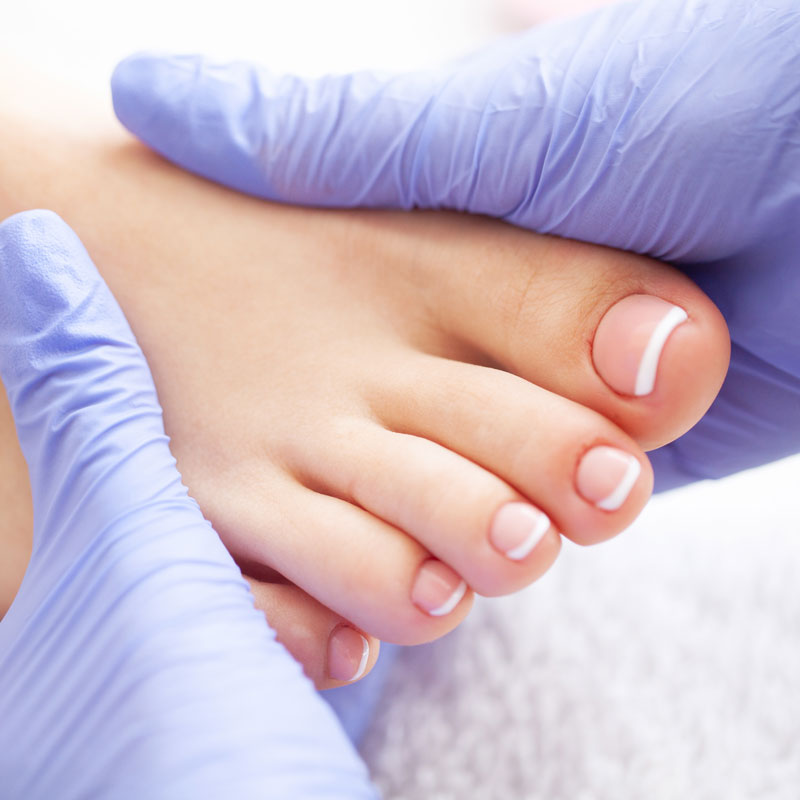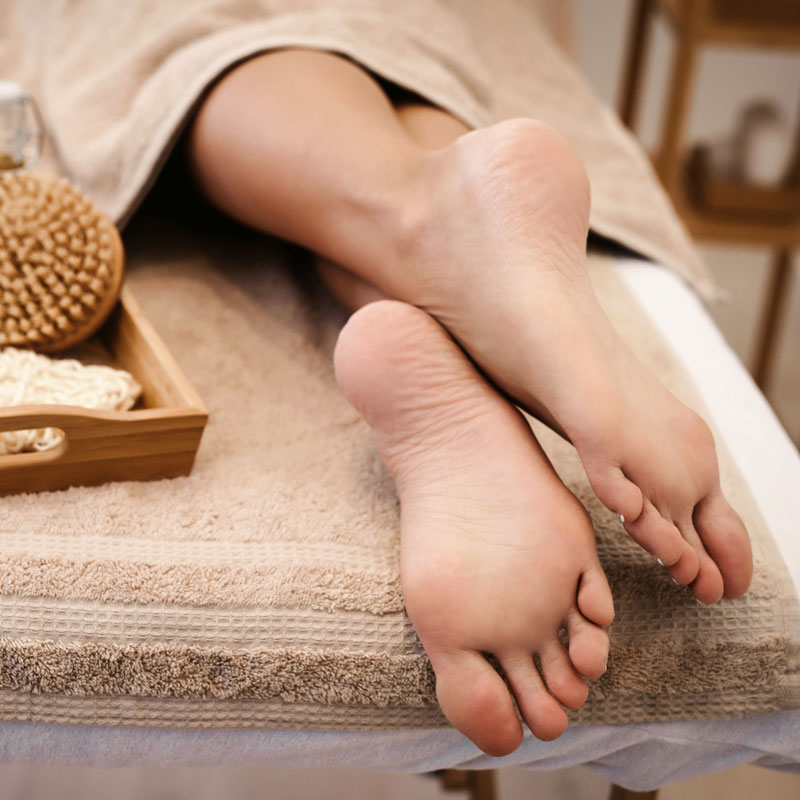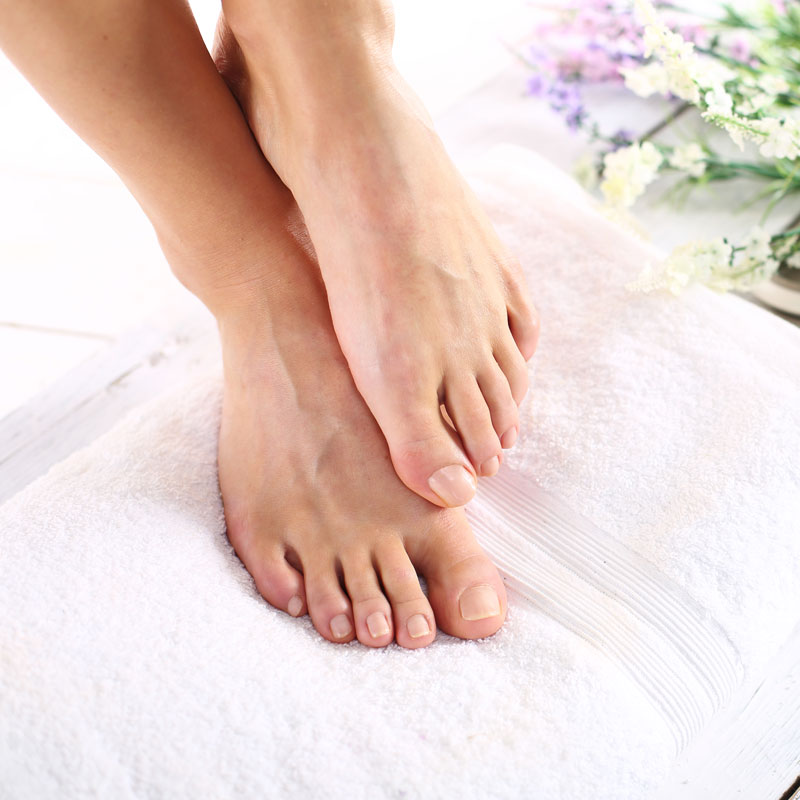Nail Problems
Toenail Problems, Prevention and Treatment in Sugar Land
Conservatively treated with topical or oral medications while others require partial or total removal of the nail. Any discoloration or infection on or about the nail should be evaluated by a podiatric physician.

Nail Ailments
Ingrown Toenails: Ingrown nails, the most common nail impairment, are nails whose corners or sides dig painfully into the soft tissue of nail grooves, often leading to irritation, redness, and swelling. Usually, toenails grow straight out. Sometimes, however, one or both corners or sides curve and grow into the flesh. The big toe is usually the victim of this condition but other toes can also become affected.
Ingrown toenails may be caused by:
- Improperly trimmed nails (Trim them straight across, not longer than the tip of the toes. Do
not round off corners. Use toenail clippers.) - Heredity
- Shoe pressure; crowding of toes
- Repeated trauma to the feet from normal activities
If you suspect an infection due to an ingrown toenail, immerse the foot in a warm salt water soak, or a basin of soapy water, then apply an antiseptic and bandage the area.
Other Causes of Nail Problems
People with diabetes, peripheral vascular disease, or other circulatory disorders must avoid any form of self-treatment and seek podiatric medical care as soon as possible.
Other “do-it-yourself” treatments, including any attempt to remove any part of an infected nail or the use of over-the-counter medications, should be avoided. Nail problems should be evaluated and treated by your podiatrist, who can diagnose the ailment, and then prescribe medication or another appropriate treatment.
A podiatrist will resect the ingrown portion of the nail and may prescribe a topical or oral medication to treat the infection. If ingrown nails are a chronic problem, your podiatrist can perform a procedure to permanently prevent ingrown nails. The corner of the nail that ingrows, along with the matrix or root of that piece of nail, are removed by the use of a chemical, a laser, or by other methods.
Fungal Nails
Fungal infection of the nail, or onychomycosis, is often ignored because the infection can be present for years without causing any pain. The disease is characterized by a progressive change in a toenail’s quality and color, which is often ugly and embarrassing.
In reality, the condition is an infection underneath the surface of the nail caused by fungi. When the tiny organisms take hold, the nail often becomes darker in color and foul-smelling. Debris may collect beneath the nail plate, white marks frequently appear on the nail plate, and the infection is capable of spreading to other toenails, the skin, or even the fingernails. If ignored, the infection can spread and possibly impair one’s ability to work or even walk. This happens because the resulting thicker nails are difficult to trim and make walking painful when wearing shoes. Onychomycosis can also be accompanied by a secondary bacterial or yeast infection in or about the nail plate.
Because it is difficult to avoid contact with microscopic organisms like fungi, the toenails are especially vulnerable around damp areas where people are likely to be walking barefoot, such as swimming pools, locker rooms, and showers, for example. Injury to the nail bed may make it more susceptible to all types of infection, including fungal infection. Those who suffer from chronic diseases, such as diabetes, circulatory problems, or immune-deficiency conditions, are especially prone to fungal nails. Other contributing factors may be a history of athlete’s foot and excessive perspiration.

Prevention
Proper hygiene and regular inspection of the feet and toes are the first lines of defense against fungal nails.
- Clean and dry feet resist disease.
- Washing the feet with soap and water, remembering to dry thoroughly, is the best way to prevent an infection.
- Shower shoes should be worn when possible in public areas.
- Shoes, socks, or hosiery should be changed more than once daily.
- Toenails should be clipped straight across so that the nail does not extend beyond the tip of the toe.
- Wear shoes that fit well and are made of materials that breathe.
- Avoid wearing excessively tight hosiery, which promotes moisture.
- Socks made of synthetic fiber tend to “wick” away moisture faster than cotton or wool socks.
- Disinfect instruments used to cut nails.
- Disinfect home pedicure tools.
- Don’t apply polish to nails suspected of infection-those that are red, discolored, or swollen, for example.
Treatment of Fungal Nails
Treatments may vary, depending on the nature and severity of the infection. A daily routine of cleansing over a period of many months may temporarily suppress mild infections. White markings that appear on the surface of the nail can be filed off, followed by the application of an over-the- counter liquid antifungal agent. However, even the best over-the-counter treatments may not prevent a fungal infection from coming back.
A podiatric physician can detect a fungal infection early, culture the nail, determine the cause, and form a suitable treatment plan, which may include prescribing topical or oral medication, and debridement (removal of diseased nail matter and debris) of an infected nail.
Newer oral antifungals, approved by the Food and Drug Administration, maybe the most effective treatment. They offer a shorter treatment regimen of approximately three months and improved effectiveness. Podiatrists may also prescribe a topical treatment for onychomycosis, which can be an effective treatment modality for fungal nails.
In some cases, surgical treatment may be required. Temporary removal of the infected nail can be performed to permit the direct application of a topical antifungal. Permanent removal of a chronically painful nail that has not responded to any other treatment permits the fungal infection to be cured and prevents the return of a deformed nail.
Trying to solve the infection without the qualified help of a podiatric physician can lead to more problems. With new technical advances in combination with simple preventive measures, the treatment of this lightly regarded health problem can often be successful.

Nail Care Tips
Proper hygiene and regular inspection of the feet and toes are the first lines of defense against fungal nails.
- Clean and dry feet resist disease.
- Washing the feet with soap and water, remembering to dry thoroughly, is the best way to prevent an infection.
- Shower shoes should be worn when possible in public areas.
- Shoes, socks, or hosiery should be changed more than once daily.
- Toenails should be clipped straight across so that the nail does not extend beyond the tip of the toe.
- Wear shoes that fit well and are made of materials that breathe.
- Avoid wearing excessively tight hosiery, which promotes moisture.
- Socks made of synthetic fiber tend to “wick” away moisture faster than cotton or wool socks.
- Disinfect instruments used to cut nails.
- Disinfect home pedicure tools.
- Don’t apply polish to nails suspected of infection-those that are red, discolored, or swollen, for example.